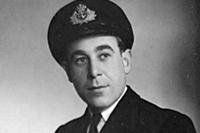Growing up on an Indiana farm in the early 20th century, Ernie Pyle yearned to travel the world. The Navy Reserve veteran got his wish while becoming the United States' most well-known war correspondent during World War II, serving as the de facto eyes and ears of Americans eager for news about their sons, husbands and countrymen from the front.
Pyle was present at so many pivotal points during the war, none more so than on D-Day. He wrote three columns in the aftermath of the Normandy invasion on June 6, 1944: "A Pure Miracle," published on June 12; "The Horrible Waste of War" on June 16; and finally "A Long Thin Line of Personal Anguish" on June 17.
Pyle traveled to France with troops on a ship transporting tanks, but he was not allowed to go ashore at Omaha Beach until the day after the invasion. The delay did little to lessen the impact of his words as Pyle, who won a Pulitzer Prize in 1944 for his war reporting, told of dead bodies lying as though they were sleeping peacefully on the sand and various personal items that served as poignant reminders of the invasion's toll.
"I picked up a pocket Bible with a soldier's name in it, and put it in my jacket," Pyle wrote. "I carried it half a mile or so and then put it back down on the beach. I don't know why I picked it up, or why I put it back down."
In "A Pure Miracle," Pyle recounts the herculean challenges that the Allies faced as Operation Overlord commenced, the rail-thin writer comparing the task at hand to being similar "[to] my whipping Joe Louis down to a pulp." He described how the Germans not only held a manpower advantage but also had prepared sinisterly for the Allies' arrival, erecting concrete gun emplacements, machine-gun nests connected by trenches, hidden ditches and mines both off- and onshore. Pyle wrote about the "great six-pronged spiders" -- shoulder-high, iron contraptions placed in the sea -- just waiting for landing craft approaching the beachhead.
Allied military leaders, including Gen. Dwight D. Eisenhower -- supreme commander of the Allied Expeditionary Force -- realized going into the invasion of Normandy that the casualty rate was likely to be high, and given what Pyle saw, it was unavoidable if the ultimate goal was to be achieved. Pyle wrote about how the first waves of troops were on the beach for hours, an excruciatingly long time, as they fought to advance inland.
But amid such long odds -- "the advantages were all theirs, the disadvantages all ours," Pyle wrote -- the war correspondent witnessed the resolve of Allied service members to continue the fight, no matter what it cost them personally, up to and including death. Although 4,415 Allied troops were killed on D-Day, according to the National D-Day Memorial Foundation, the losses could not be tallied only in a body count, as Pyle laid out in "The Horrible Waste of War."
In that column, Pyle described walking for 1½ miles along the beach and seeing destroyed military vehicles everywhere he looked. Pyle talked about landing craft tanks (LCT) turned upside down, boats on top of each other, half-sunk barges and "the angled-up corners of jeeps."
The journalist also spotted rolls of barbed wire and piles of life belts amid what he described as "this shoreline museum of carnage."
"The wreckage was vast and startling," Pyle recounted. "The awful waste and destruction of war, even aside from the loss of human life, has always been one of its outstanding features to those who are in it. Anything and everything is expendable. And we did expend on our beachhead in Normandy during those first few hours."

In "A Long Thin Line of Personal Anguish," Pyle turned his attention to the personal effects left behind by troops no longer in need of them. There were Bibles, soldiers' packs, pocketbooks, diaries, clothing and "bloody abandoned shoes." The journalist found first-aid kits as well as letters from home with their addresses removed for security concerns. Pyle even discovered a tennis racket, all of its strings improbably intact.
Pyle came across a dog, searching against hope for the service member to whom he belonged, and troops working feverishly to move supplies into France to keep the Allies fortified.
When Pyle climbed atop a bluff, where the Allies had constructed a tent hospital and prisoner-of-war camp, he was awestruck in "The Horrible Waste of War" by what he saw at sea -- "the greatest armada man has ever seen and a giant collection of ships waiting to unload." Reinforcements were nearby, and a group of German POWs saw them, too.
"They didn't say a word to each other," Pyle remembered. "They didn't need to. The expression on their faces was something forever unforgettable. In it was the final horrified acceptance of their doom."

Operation Overlord lasted until Aug. 30, 1944, when the Allies liberated northern France. Indiana University, which Pyle attended, has maintained a collection of his most notable World War II columns -- an enduring testament to the front-row seat that Pyle had to what he described during the Normandy invasion as "the spirit that wins battles and eventually wars."
Pyle, 44, was covering the war in the Pacific when he was killed on April 18, 1945, in the Ryukyu Islands.
Want to Know More About the Military?
Be sure to get the latest news about the U.S. military, as well as critical info about how to join and all the benefits of service. Subscribe to Military.com and receive customized updates delivered straight to your inbox.


























